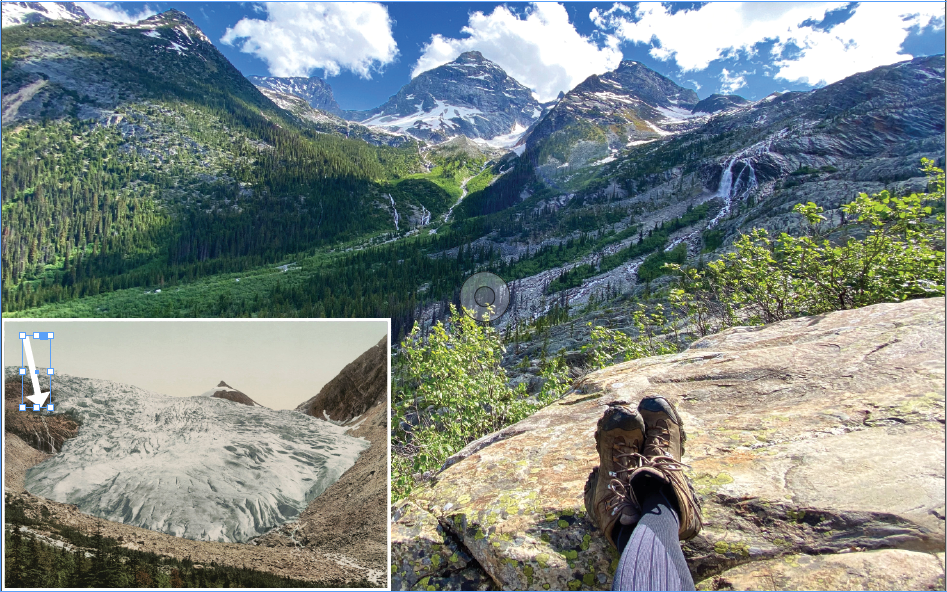Like all First Nations, the Nłekepmxc see everything in nature as interconnected. So no surprise this is a main theme as nation-member Tim Patterson of Zucmin Guiding leads us on a journey of understanding through the forests of Rogers Pass. As the sun bends its way down through the trees, the warming in open spaces is met by zephyrs of cool air that swirl over lingering snow patches. With airborne phenols from spruce, fir and cedar stirred in, the overall effect is of marching through a giant cosmic air freshener.
Tim is deeply knowledgeable (ACMG hiking leader, Master Educator with Leave No Trace, Field Instructor with the Outdoor Council of Canada, Master’s degree in Environmental Education, and Indigenous Interpretive Guide specializing in mountain environments) and has much to share about Indigenous use of various tree species—whether for cleaning, sustenance or other purposes. He quietly passes on his greatest reverence, however, for “the boss tree”—the Interior Douglas-fir used in culinary, medicinal, cultural and technological applications. Not to mention that these sentinels are, as always, the most impressive arbour in the forest. Even smaller versions, as here, growing at what was once the foot of one of Western Canada’s most impressive ice floes—impressive enough to be called The Great Glacier, a template for geological, human and, eventually, climate stories.
Although they tapped the area we’re forging into for resources, it was never actually occupied by First Nations, who lived in valleys to either side of the pass given, as Tim explains, the difficulty of its steep terrain, dense vegetation, prodigious snows, thundering avalanches and tricky glaciers that descended almost to the pass. A more recent, European human history of the area kicks off with Major A.B. Rogers, a surveyor employed by the Canadian Pacific Railway (CPR) who discovered this much-sought singular way through the Selkirk Mountains. When the transcontinental railway was completed in 1885, Rogers Pass became one of Western Canada’s first tourist destinations. Glacier National Park opened in 1886, and Glacier House, a small hotel, sprang up on the rail line near the glacier’s terminus, expanding in 1892 and 1904. Swiss guides were brought in to lead guests to the ice, which, by 1907, was the “most visited glacier in the Americas.”
Initially labelled “Great Glacier” by CPR promoters, the Interior Salish word Illecillewaet (“big water” says Tim) was already in use for its meltwater river, and gradually replaced the former appellation before being officially adopted by Parks Canada in the 1960s. The influx of visitors over the years has included both mountaineers and glaciologists, and thus, though sparse by European standards, studies made of the Illecillewaet Glacier are among the most detailed for North America. This proved fortuitous given rapid retreat of the ice that began almost as soon as tourists arrived, stretching back several kilometres over the course of a century. With the hotel’s raison d’être in jeopardy, re-routing of the railroad in 1911 to make the line less vulnerable to avalanches (more than 250 people died during construction and the years following) put a final nail in its coffin, and Glacier House closed in 1925, after which it was deconstructed down to the foundations.
Beginning the hike, we walk the abandoned rail bed past the hotel’s historic remains, turning onto a path that guests would stroll after dinner to get a look at the ice. From the gravel-bar lookout, we ascend beside the Illecillewaet River, the forest now constellated with house-sized glacial erratics and stranded mounds of rock and till, a Pleistocene tale of the glacier’s profound effect on the land. Above us, from every angle it seems, lords Mount Sir Donald, the sharp, Matterhorn-like peak that in many ways defines the pass. Eventually leaving the river and forest behind, we labour up a steep, alder-choked slope where the substrate turns to fine dust mixed with gravel—the remains of a towering lateral moraine. Rock-hopping a small stream flowing off the remaining ice, still high above us and out of sight, we step across glacier-polished rock whose iron content sees it rusting in the air, and lunch where the ice once sat as recently as my teenage years. I’d first glimpsed the Illecillewaet Glacier from the window of a van headed west to Whistler, and though my memory is all that remains of the ice at this location, I recognize waterfalls and landmarks from old photos seen on interpretive panels at the bottom of the trail, a climate-change story writ large.
By conservative estimate, I’ve driven through Rogers Pass probably 50 times, but only ever stopped in one spot—the summit—whether it was to use the facilities, tour Parks Canada’s modest museum, or, when it still existed, log a night at the infamously decrepit, mega-A-frame, Glacier Park Lodge for ski-touring. Seeing the waypoints of the pass on the ground like this, hiking to learn about how the area’s Indigenous, European, geological and climate histories weave together, enriches my perspective.
The ice might be gone, but fascination with the pass doesn’t change. And later, as we all settle into chairs with cocktails in hand on the deck of Heather Mountain Lodge, a cosy, wood-beam structure just off the TransCanada Highway on the east side of the pass, watching alpenglow wash over the peaks and what remains of once great glaciers feels like less of a sunset to the day than the coda to an entire era.
Leslie Anthony is a biologist, writer and author of several popular books on environmental science.


.jpg;w=120;h=80;mode=crop)

